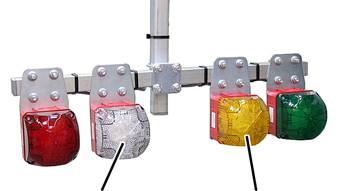
White signal lamp for crane travel
Yellow signal lamp for trolley travel
In tandem operation the crane travel limit switch and the trolley travel limit switch as well as the overload protection and the hoist limit switch on the hoist are evaluated together.
The behaviour of crane, trolley and hoist during the braking function in tandem operation is somewhat different than on a crane without a tandem control system.
Summary:
In tandem operation, both cranes, trolleys and hoists brake completely when the switching point for the braking function is reached (intermediate stop for all three crane axes). In order to continue travel (no matter whether with the crane, trolley or hoist), the button must be switched back from fast to slow travel speed first.
When the cranes travel at high speed:
|
| |
|
White signal lamp for crane travel |
Yellow signal lamp for trolley travel |
● If one of the cranes reaches the switching point for the braking function, both cranes make an intermediate stop (both cranes brake completely and come to a standstill).
● The intermediate stop also affects the hoist and the trolley: These also come to a standstill if they were being moved.
● The white signal lamp for crane travel goes off on the crane on which the switching point has been reached.
 Release the button for
crane travel partly or completely.
Release the button for
crane travel partly or completely.
● The signal lamp will light up again.
 If necessary, press the
button for crane travel halfway again (stage 1) and continue to travel at low
speed in the limit switch range
If necessary, press the
button for crane travel halfway again (stage 1) and continue to travel at low
speed in the limit switch range
or
continue travel if necessary in the opposite direction out of the limit switch range at high or low speed
or
move, lift or lower the trolley or hoist at fast or slow travel speed.
When the trolleys travel at high speed:
Trolley travel behaves in exactly the same way as crane travel with the braking function. In the case of trolley travel, the yellow signal lamp goes off when the switching point has been reached.
The behaviour of crane, trolley and hoist during shut-down in tandem operation is somewhat different than on a crane without a tandem control system.
Summary:
In tandem operation, both cranes, trolleys and hoists brake completely when the switching point for shut-down is reached (intermediate stop for all three crane axes). In order to continue travel (no matter whether with the crane, trolley or hoist), the button must be released completely from the slow travel speed first.
When the cranes travel at low speed in the limit switch range:
|
| |
|
White signal lamp for crane travel |
Yellow signal lamp for trolley travel |
● If one of the cranes reaches the switching point for shut-down, both cranes make an intermediate stop (both cranes brake completely and come to a standstill).
● The intermediate stop also affects the hoist and the trolley: These also come to a standstill if they were being moved.
● The white signal lamp for crane travel goes off on the crane on which the switching point has been reached.
● One of the cranes is at the outermost point of the limit switch range and cannot travel any further.
 Release the button for
crane travel completely.
Release the button for
crane travel completely.
 Continue travel if
necessary in the opposite direction out of the limit switch range at high or low
speed
Continue travel if
necessary in the opposite direction out of the limit switch range at high or low
speed
or
move, lift or lower the trolley or hoist at fast or slow travel speed.
When the trolleys travel at low speed in the limit switch range:
Trolley travel behaves in exactly the same way as crane travel with shut-down. In the case of trolley travel, the yellow signal lamp goes off when the switching point has been reached.
The behaviour of crane, trolley and hoist at the top or bottom emergency limit switch in tandem operation is somewhat different than on a crane without a tandem control system.
Summary:
In tandem operation, both cranes, trolleys and hoists brake completely when the top or bottom emergency limit switch is reached (intermediate stop for all three crane axes). In order to continue travel (no matter whether with the crane, trolley or hoist), the button must be released completely from the slow or fast travel speed first.
When the hoists lift or lower:
|
| |
|
|
Green signal lamp for lift/lower |
● If one of the load hooks reaches the top or bottom emergency limit switch both cranes make an intermediate stop (both cranes brake completely and come to a standstill).
● The intermediate stop also affects the crane and the trolley: These also come to a standstill if they were being moved.
● The green signal lamp for lift/lower goes off on the crane on which the emergency limit switch has been reached.
 Release the button for
lift/lower completely.
Release the button for
lift/lower completely.
 Continue travel if
necessary in the opposite direction out of the limit switch range at fast or
slow lifting speed
Continue travel if
necessary in the opposite direction out of the limit switch range at fast or
slow lifting speed
or
move the trolley or crane at a high or low speed.